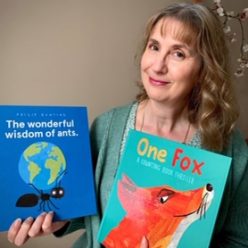Illustrated by Charlotte Molas

Published by Tate Publishing, London, 2021
There’s a lovely little paragraph at the beginning of this book by the author and illustrator, thanking the French railway company for their serendipitous meeting one Saturday in November where they encountered each other in seats 65 and 66 on the journey from Hendaye to Paris. This picture book may never have existed if that meeting had not taken place, and that would have been a shame, the world needs more stories about unicorns!
Beginning with the capture of unicorn by a young Siberian explorer, we follow the ups and downs of her experiences as she gets passed on to one owner and another by foul or fair means. Unicorn is lost in a game of cards, won by fishermen, sold to a knight, passed on to an athlete, used by a robber, shot out of a cannon, and remodelled as a coat rack.
Each experience is plausibly told in a few short sentences, and unicorn does her best to go with the flow, whether she is happy or not, well cared for or not. But unicorn finds real happiness at the end when the narrator finds her in an old antique shop, sensibly puts her on the Trans-Siberian Express train and leaves her at the edge of the snowy forest that is her home in the wild.
This story reminded me of Black Beauty by Anna Sewell, a story of a horse that is passed from one owner to another and endures the good times and bad times with strength of character and patient stoicism. Both stories help us to understand how to endure the capricious nature of life and to bend with whatever circumstances we find ourselves in. With some luck, some kindness and good fortune, the tale ends happily for unicorn, which is just as it should be for this fabled creature!
The illustrations greatly enhance the telling of the story and show an enormous variety of uses for a unicorn’s horn! (a safe opener, really?) There are a few colourful double page spreads, but mostly the sparse coloured text sits on a white page next to the illustration on the other page, the colours complementing each other beautifully.
I can highly recommend this picture book for children 4-6 years, and below I have further suggestions for picture books which feature magical unicorns:

by Ame Dyckman
Illustrated by Liz Climo


by Amy Young

by Morag Hood
Illustrated by Ella Okstad

by Aaron Blabey


by Anna Currey

by Robert Heidbreder
Illustrated by
Kady MacDonald Denton

by Fiona Watt
Illustrated by Rachel Wells

by Lou Carter
Illustrated by Nikki Dyson

by Rachel Lyon
Illustrated by Andrea Ringli


by Julia Donaldson
Illustrated by Lydia Monks

Illustrated by Katy Halford



and Mark Baker

by Saviour Pirotta
Illustrated by Jane Ray

by Gabby Dawnay
Illustrated by Alex Barrow
And for older readers:

by Michael Morpurgo
Illustrated by Gary Blythe


















































































































































































































